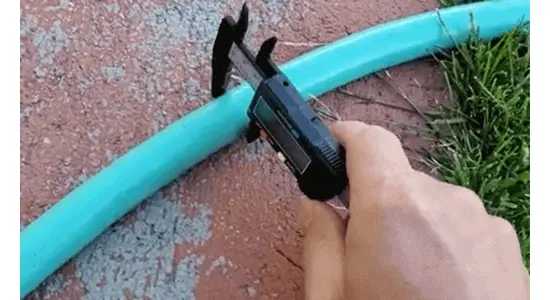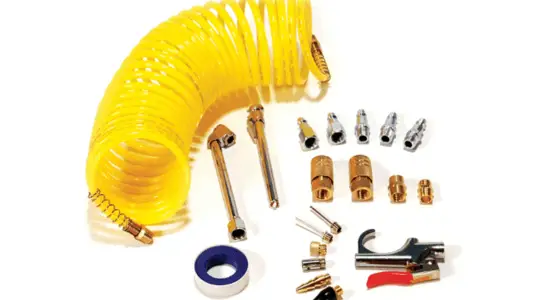Table of Contents
What Size Hose for Air Compressor?
Selecting the right size hose for your air compressor ensures optimal performance and efficiency in powering your air tool. Understanding how to size an air compressor correctly can minimize downtime and avoid the pitfalls of using an overpowered or undersized unit.
Generally, a 3/8-inch hose is suitable for most air compressors as it provides a good balance between airflow and pressure drop. For longer distances or higher airflow requirements, a larger hose diameter, such as 1/2 inch, may be necessary to minimize pressure losses.
However, you must consider the other factors that may affect the hose size selection, such as application, temperature, hose material, end fittings, etc. To learn it in detail, stay with me; I will explore ways and factors to consider for determining the hose size. Let’s get started.
Understanding Hose Size Measurements

Understanding hose size measurements is essential when selecting the correct hose for an air compressor. Hose sizes are expressed in their inside diameter (ID) and outside diameter (OD). The ID refers to the inner opening of the hose, while the OD is for the outer circumference.
Hose sizes are commonly designated in fractions, such as 1/4″, 3/8″, or 1/2″. These fractions represent the nominal size of the hose’s ID. For example, a 1/4″ hose has an ID of 1/4 inch. It is essential to note that the OD of a hose may vary depending on its construction and material.
Choosing the correct hose size for an air compressor needs essential factors to get the required airflow and the pressure rating of the compressor.
Larger hose sizes, such as 3/8″ or 1/2″, can handle higher airflow and are suitable for heavy-duty applications. Smaller hose sizes, such as 1/4″, are commonly used for DIY tasks or portable compressors.
Understanding hose size measurements ensure excellent compressor, accessories, and tool compatibility. It enables efficient air transfer, minimizes pressure drops, and helps maintain excellent performance.
Hose Size Chart for Air Compressor: Common Application
| Hose Size ( ID) | Hose Size ( OD) | Applications |
| 1/4″ | Varies | DIY tasks, portable compressors |
| 3/8″ | Varies | General applications, medium-duty tasks |
| 3/4″ | Varies | Industrial-grade pneumatic tools, high CFM requirements, large air compressors, heavy machinery |
| 1/2″ | Varies | Heavy-duty applications, high airflow requirements |
How to Determine the Required Hose Size?
The correct hose size is essential for the best performance and accurate pressure. Follow the steps given below to determine the correct required hose size for your air compressor.
Step 1- Understand the required airflow
First, identify the required airflow. You will need to measure it in cubic feet per minute. You should determine the required CFM for your specific application. You can easily determine it by reading it from the air tool manufacturer’s manual or consulting with an expert.
Step 2- Check your air compressor output
Next, you have to identify the maximum output of your compressor. It will be in CFM. Check for maximum output on the user’s manual.
Step 3- Calculate the hose size
Now use the simple formula and calculate the hose size for your air compressor. Below is the formula for calculating the required hose size.
Hose size= Required CFM/ Compressor’s CFM output
You can find the right hose size needed for the required airflow throughout this formula.
Note: I recommend a slightly larger size than the required size because it ensures flexibility for optimum performance.
Step 4- Consider Hose length
When determining its size, it is also essential to consider the hose’s length. If you need to use a bigger hose to maintain the pressure level, bringing one with a slightly larger diameter is preferable.
Step 5- Cross match with Hose Size Chart
Once you have determined, it is better to cross-match it with reputable sources. You can find the hose size chart in the user manual of the air tool or on the internet. Once the chart is found, compare it with your determined value to cross-match you have determined the correct size.
What Factors Influence Hose Size Selection?

- Temperature
The temperature of the medium being conveyed through the hose is a crucial factor in hose size selection. Different materials have varying temperature limitations, and exceeding these limits can result in hose failure.
High temperatures can cause the hose to degrade, leading to leaks or bursts. Conversely, extremely low temperatures can make the hose material brittle and prone to cracking. Selecting a hose with the appropriate temperature rating ensures safe and reliable operation.
- Application
The specific application for which the hose will be used significantly determines the appropriate hose size. Different applications have varying pressure, flow rate, flexibility, and compatibility demands.
For example, industrial applications may require hoses capable of withstanding high pressures. On the other hand, DIY applications have different requirements.
- Medium
The nature of the medium flowing through the hose is another key consideration. Various fluids and substances have different properties, such as viscosity, corrosiveness, and abrasiveness. These properties can impact the selection of hose material and the hose’s inner diameter and wall thickness.
Choosing a hose compatible with the conveyed medium ensures efficient and safe transport. For air or water, you need slightly larger diameters than required.
- Pressure
The system’s operating pressure is also an essential factor to consider. Hoses are designed to support specific pressure ranges. If you use an inadequate hose to handle the pressure, it may fail or damage.
So, choosing the correct hose size is essential for safety assurance and performance. First, check your selected hose’s maximum output to ensure you have the right hose to handle the required pressure.
- Ends and Delivery
The type of ends and the desired delivery system are also factors for hose size. Different applications may require specific end fittings, such as couplings or connectors, which need to match the hose size.
Furthermore, the desired flow rate and distance the medium travels also affect the hose size. Factors such as friction losses and flow restrictions must be accounted for to ensure efficient and effective delivery.
What Other Considerations While Choosing Hose Size?
Here is the list of some other considerations that must be accounted for while choosing the hose size.
- Material
The material of the hose is also essential to consider to make it compatible with the specific application. Because different materials offer different levels of resistance to abrasion, chemicals, and temperature.
- Fittings
Ensure that the hose size matches the fittings or connectors you plan to use. Ensure the fittings are compatible with pressure for a secure and leak-free connection.
- Flow rate
It is also essential to consider the flow rate requirements of your application. A smaller hose diameter may restrict flow. It may cause reduced efficiency, while a larger diameter may result in excessive pressure drop.
- Environment
Environmental conditions are also essential for the hose for better performance. You have to consider where your hose will be exposed to, such as extreme temperatures, UV radiation, or exposure to chemicals. Select a hose that is suitable for those conditions.
- Flexibility
Assess the flexibility needed for the hose to navigate around obstacles or bend without kinking. Some applications may require more flexibility than others.
FAQs: Hose Size for Air Compressor
Can I use any size hose with a high-pressure air compressor hose?
No, you cannot use any size hose with a high-pressure air compressor. The hose size should be appropriate for the compressor’s maximum pressure and flow rate. Using an incompatible hose size may result in reduced performance or even damage to the equipment.
Does length of the hose affect the performance of harbor freight air compressor hose?
Yes, the hose length can affect the performance of a Harbor Freight air compressor. Longer hoses can cause a decrease in air pressure, resulting in reduced efficiency and performance. Using the shortest hose necessary for the task to maintain optimal performance is generally recommended.
Is it better to have a larger or smaller diameter hose for my air compressor?
The hose size for an air compressor depends on your equipment’s specific requirements. In general, a larger diameter hose allows for higher airflow and reduces pressure drop, resulting in better performance. However, it is important to consider compatibility with your compressor and its intended use.
Can I use a longer hose with a smaller diameter for my air compressor?
Using a longer hose with a smaller diameter for your air compressor can decrease airflow and pressure loss. It’s recommended to use a hose with the appropriate diameter specified by the compressor manufacturer.
Conclusion
Determining the right size hose for your air compressor is essential for optimal performance. You have to need to consider many factors to choose the accurate size. It is recommended to consult the manufacturer’s guidelines and select a hose that can handle the required pressure and flow rate. It will ensure your tool’s performance and enhance your safety level.

